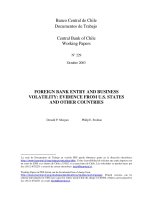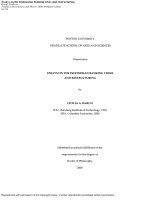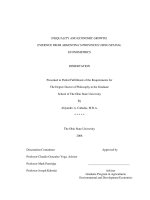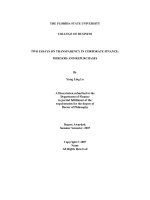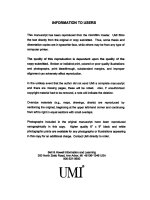Essays on real assets, corporate investment and equity financing evidence from u s capital markets and securitized real estate
Bạn đang xem bản rút gọn của tài liệu. Xem và tải ngay bản đầy đủ của tài liệu tại đây (1.6 MB, 157 trang )
ESSAYS ON REAL ASSETS, CORPORATE INVESTMENT AND
EQUITY FINANCING: EVIDENCE FROM U.S. CAPITAL
MARKETS AND SECURITIZED REAL ESTATE
DENG XIAOYING
(B.A. SOUTHWESTERN UNIVERSITY OF FINANCE AND
ECONOMICS)
A THESIS SUBMITTED
FOR THE DEGREE OF DOCTOR OF PHILOSOPHY
DEPARTMENT OF REAL ESTATE
NATIONAL UNIVERSITY OF SINGAPORE
II
DECLARATION
I hereby declare that this thesis is my original work and it has been written by
me in its entirety. I have duly acknowledged all the sources of information
which have been used in the thesis.
This thesis has also not been submitted for any degree in any university
previously.
_____________________
DENG XIAOYING
26 June 2014
III
ACKNOWLEDGEMENTS
The China Scholarship Council is highly acknowledged for their financial
support over my entire Ph.D. study.
I am deeply indebted to my supervisor, Prof. Ong Seow Eng, who bestows his
professionalism upon me via his wisdom in academics, eloquence in
discussion, and grace in temperament. Without his patient guidance and
relentless support throughout the Ph.D. program, the completion of this thesis
would not have been possible. My heartfelt thanks also go to Prof. Deng
Yongheng, who gave me considerable help by means of suggestion, comments
and criticism.
Besides, I am grateful to Prof Fu Yuming, Prof Qian Meijun, Prof David M.
Reeb, Prof Nan Li, Prof Tu Yong, Prof Liao Wen-chi, Prof Seah Kiat Ying
and Dr. Emir Hrnjic, for their dedications to my coursework teaching and
valuable comments on my dissertation. I am also pleased to acknowledge my
friends for their invaluable assistance throughout the preparation of the
original manuscript.
Finally, I would like to express my gratitude to my beloved parents, who have
shown me the beauty of life. My father, a mentor and friend, inspires me to be
always positive, constantly passionate and unfailingly cheerful. My mother,
who passed away in the spring of 2010, let me know “suffering produces
perseverance; perseverance, character; and character, hope”, where hope
brings about joy, dream and love. Of course, this thesis is dedicated to them.
IV
TABLE OF CONTENTS
ACKNOWLEDGEMENTS III
LIST OF TABLES VI
LIST OF FIGURES VII
SUMMARY VIII
CHAPTER 1 INTRODUCTION 1
1.1 Research Background 1
1.2 State of The Art 2
1.3 Research Objective 3
1.4 Intended Contribution 5
1.5 Organization of the Thesis 7
CHAPTER 2 REAL ESTATE RISK, CORPORATE INVESTMENT
AND FINANCING CHOICE 9
2.1 Introduction 10
2.2 Literature Review 14
2.2.1 Corporate investment and asset-in-place 14
2.2.2 Real estate and asset pricing 15
2.2.3 Real estate and corporate policies 16
2.3 Hypothesis 18
2.4 Data and Empirical Design 21
2.4.1 Measuring Real Estate Factor 22
2.4.2 Measuring Firm-level Real Estate Factor 23
2.4.3 Real Estate Factor and Corporate Investment 24
2.4.4 Real Estate Risk and Corporate Financing Choice 25
2.4.5 Control variables 26
2.5 Empirical Results 26
2.5.1 Descriptive Statistics 26
2.5.2 Real Estate Risk and Corporate Investment 28
2.5.3 Real Estate Risk and Corporate Financing Choice 29
2.6 Robustness Check 32
2.7 Conclusions 32
CHAPTER 3 REAL EARNINGS MANAGEMENT, LIQUIDITY AND
REITS SEO DYNAMICS 44
3.1 Introduction 45
3.2 Literature Review 48
3.2.1 Real Earnings Management 48
3.2.2 REITs Seasoned Equity Offerings 50
3.2.3 Liquidity Risk 52
3.3 Hypothesis 53
3.1 Data and Sample Description 55
3.4 Research Design 56
3.4.1 Real Earnings Management Measure 56
3.4.2 Liquidity-augmented CAPM 58
3.4.3 Pre-SEO Misvaluation 59
3.4.4 Control Variables 61
3.5 Empirical Results 62
3.5.1 Empirical Evidence of Real Earnings Management 62
V
3.5.2 Determinants of Real Earnings Management 63
3.5.3 Uninformed Trading and Real Earnings Management 64
3.5.4 Real Earnings Management and SEO Price Dynamics 66
3.6 Robustness Test 71
3.7 Conclusions 71
CHAPTER 4 INVESTOR SENTIMENT AND SEO PRICING:
EVIDENCED FROM REITS 82
4.1 Introduction 83
4.2 Literature Review 88
4.2.1 Investor Sentiment 88
4.2.2 SEO Price Dynamics 90
4.2.3 Investor Sentiment and Equity Offerings 92
4.3 Empirical Implications 93
4.4 Data 96
4.5 Research Design 96
4.5.1 Survey-based Proxies for Investor Sentiment 96
4.5.2 Indirect Measure of Sentiment 98
4.5.3 Pre-SEO Misvaluation 99
4.5.4 SEO Announcement Return 101
4.5.5 SEO Discounting and Underpricing Variables 101
4.5.6 Long-run Abnormal Return 102
4.5.7 Control Variables 102
4.6 Empirical Results 104
4.6.1 Descriptive Statistics 104
4.6.2 Sentiment and Pre-SEO Misvaluation 104
4.6.3 Sentiment and SEO Probability 106
4.6.4 Sentiment and SEO Announcement Effect 107
4.6.5 Sentiment and SEO Discounting 108
4.6.6 Sentiment and SEO Underpricing 110
4.6.7 Sentiment and SEO Long-run Return 111
4.7 Robustness Tests 112
4.7.1 Asymmetric Effect of Sentiment 113
4.7.2 Hot Market Effect 113
4.8 Conclusions 114
CHAPTER 5 CONCLUSIONS 133
5.1 Background 133
5.2 Summary of Major Findings and Implications 133
5.3 Limitations and Further Research 135
BIBLIOGRAPHY 138
APPENDIX 147
VI
LIST OF TABLES
Table 2.1 Descriptive Statistics 34
Table 2.2 Average Returns, Post-Ranking βs For Portfolios Formed on Size
and then Real Estate β: 1985 to 2010 36
Table 2.3 Real Estate Risk and Corporate Investment 38
Table 2.4 Real Estate Risk and Corporate Investment during the subprime
crisis 38
Table 2.5 Real Estate Risk and Long Term Debt Issuance 40
Table 2.6 Real Estate Factor and Probability of Equity Issuance 41
Table 2.7 Real Estate Factor and Net Equity Issuance 42
Table 2.8 Real Estate Factor and Capital Structure 43
Table 3.1 Descriptive statistics for REITs firms conducting SEOs during
2000–2011 74
Table 3.2 Determinants of Real Earnings Management prior SEOs 76
Table 3.3 Real Earnings Management and Abnormal Trading Volume prior
SEO 77
Table 3.4 Real Earnings Management and PreSEO Valuation 78
Table 3.5 Real Earnings Management and SEO discounting 79
Table 3.6 Real Earnings Management and SEO Discounting (Probit Model) 80
Table 3.7 Real Earnings Management and SEO Long-run Performance 81
Table 4.1 Estimation of Investor Sentiment Proxies 117
Table 4.2 Time-Series Average Conditional Regression Coefficients 119
Table 4.3 Descriptive Statistics 120
Table 4.4 Investor Sentiment and pre-SEO Valuation 121
Table 4.5 Investor Sentiment and the Probability of SEO Issuance 122
Table 4.6 Investor Sentiment and SEO Announcement Effect 123
Table 4.7 Investor Sentiment and SEO Discounting 124
Table 4.8 Investor Sentiment and SEO Underpricing 126
Table 4.9 Investor Sentiment and SEO Long-run Risk Adjusted Return 128
Table 4.10 Asymmetric Effect of Investor Sentiment 131
Table 4.11 Decision to Issue in High Sentiment Period 132
VII
LIST OF FIGURES
Figure 2.1 The market factor and the real estate risk from 1985 to 2010 35
Figure 3.1 Real Earnings Management around REITs SEOs 75
VIII
SUMMARY
This thesis deepens the understanding of real estate in the capital markets by
addressing following three questions (1) how real estate risk influences
corporate policies; (2) how securitized real estate manages the liquidity risk
using real activities manipulation; (3) how investors’ behaviour affects the
equity pricing in the securitized real estate market.
In the first essay, I ask how capital heterogeneity influences corporate
investment given that an option to grow the company through investment is
subject to the riskiness of the firm’s asset. Using the US general firm data
from 1985 to 2010, I include shocks to the real estate market as a proxy for
state-variable risk in the asset pricing model and construct the real estate risk
factor at the firm level. I document that the real estate risk embedded in
corporate real estate holdings affects the corporate investment decisions made
by firms’ managers (a negative effect), and further decreases long-term
external financing in both equity and debt.
In the second essay, I look into the characteristics of the securitized real estate,
Real Estate Investment Trusts (REITs). I explore how REITs manage the
liquidity risk in the equity market considering that real estate is less liquid
compared with other asset classes in nature. I show that REITs managers
engage in real earnings management to attract more uninformed trading in
order to provide the liquidity services at lower cost during seasoned equity
offerings. I find less liquid REITs are more likely to manipulate earnings prior
equity offerings, and uninformed trading is higher following the real earnings
IX
management. REITs set the offer price at a smaller discount after engaging in
real earnings management and stock returns decline in the long run. The
findings are consistent with real option and liquidity explanations for equity
offerings.
In the third essay, I study the pricing of the securitized real estate market from
a behavioural perspective. I answer whether investor sentiment contributes to
the price anomaly in REITs equity offerings, empirically addressing that
REITs managers time the market to issue equity by timing the sentiment
investors and the behaviour of investors impacts price formation around
seasoned equity offerings. Consistent with the notion that market interprets
SEO announcement in high sentiment periods as more negative signal, I find
that announcement returns are negatively related to sentiment. Further, I
document that investor sentiment is positively related with the SEO
discounting and first day returns. Finally, sentiment does not seem to proxy for
unobservable risk characteristic as I find that post-SEO long run returns are
more negative in high sentiment periods.
Overall, this thesis highlights the importance of real estate in corporate
investment and corporate financing strategies. This research provides
significant information on real estate values from novel perspectives as well as
guidance to the corporate policy decisions making for different firm managers.
1
CHAPTER 1 INTRODUCTION
This PhD thesis bundles three empirical essays on the role of real estate asset
in capital market, aiming to provide significant information on real estate
values from novel perspectives as well as guidance to the corporate policy
decisions making for different firm managers.
1.1 Research Background
Real estate composes a significant part of firm’s portfolio. According to the
survey in Zeckhauser and Silverman (1983), real estate assets comprise one-
quarter of firm’s assets on average. For manufacturing firms, this figure
increases to about 40%.
Firm owns real estate for a variety of reasons. Real estate has a slow
depreciation rate (Glaeser and Gyourko 2005). According to the Bureau of
Economic Analysis report, non-residential real estate depreciates at a rate
between 1.5% and 3%, far more slow than the other equipment. Unlike
equipment, real estate is heterogeneous in space, which varies even cross the
firms in the same industry. The lower risk embedded in real estate assets
compared to other risky assets alters a firm’s underlying risk, which makes
real estate an ideal investment strategy for portfolio diversification as well as
inflation hedge. All the features of corporate real estate make corporate
policies complex for corporate real estate holding firms.
Firms can hold the real properties either by investing directly in real estate
market or via securitized real estate. The development of securitized real estate
has further bridged the capital market and the real estate market, which makes
2
the real estate strategies feasible for both corporate and individual investors.
The most common form of securitized real estate is Real Estate Investment
Trusts (REITs). Created in United States, REITs offer institutions and
individuals the opportunities to invest in real properties. The tax-exempt
feature of REITs requires REITs to distribute a minimum 90% of their taxable
income to investors as dividends, limiting the possibility of free cash flow.
Restricted investment options on real estate assets, REIT managers’ cannot
simply boost their compensation through activities like merger and
acquisitions and also the dual performance measurement by net income and
funds from operation limits agency problems.
Regardless of recent advances in direct and securitized real estate,
understanding of real estate in the context of capital market remain obscure, as
both corporate and individual investors are uncertain about how far to invest in
real estate due to the lack of sufficient information on the real estate vehicles.
1.2 State of The Art
Despite the recognized importance of real estate in many firms’ production
and investment, past studies provide limited analysis on the effects of real
estate. The finance literature has focused on the collateral effect of real estate
assets. An increase in real estate value will exert a positive collateral effect on
corporate investment. Gan (2007) uses a difference-in-difference approach,
documenting that real estate holding firms are more vulnerable to real estate
bubble bust than non-real estate holding firms in Japan. Chaney, Sraer and
Thesmar (2012) finds a similar result using the U.S. firm data, concluding that
firms expand investment via debt issuance when real estate prices increase as
3
they use real estate for project financing. In a production economy, Tuzel
(2010) solves a general equilibrium with a high irreversibility cost for real
estate and justifies that low depreciation rate of real estate deteriorates real
estate holding firms’ capacity to productivity shocks. The amplified risk of
real estate drives investors for a return premium when they invest in firms
concentrated in real estate ownership(Ling, Naranjo and Ryngaert 2012).
Meanwhile, capital adjustment cost is asymmetric, which indicates that firms
are less flexible in downsizing capitals in bad times. Since the capital stocks of
real estate holding firms have been more long-lived, countercyclical real estate
risk would serve as an important factor for corporate investment, which,
according to my knowledge, has not been examined in the existing literature
before.
Besides, for the equity pricing in the securitized real estate market, literature
suggests that firms time seasoned equity offerings (SEO, thereafter) either by
selling the overpriced shares (window of opportunity/behavioral hypothesis)
or by exploiting the time-varying risk to minimize the cost of equity (the risk-
trade off hypothesis). In the context of REITs, I revisit those above hypothesis
by analyzing from real earnings management and investor sentiment
perspectives, both of which emerge out in recent years, to test whether real
earnings management and investor sentiment stories reconcile with the current
theoretical implications.
1.3 Research Objective
This thesis deepens the understanding of real estate in capital market by
addressing following three questions (1) how real estate risk influences
4
corporate policies; (2) how securitized real estate manages the liquidity risk;
(3) how investors’ behaviour affects the pricing in securitized real estate
market.
In the first essay, I ask how capital heterogeneity influences corporate
investment given that an option to grow the company through investment is
subject to the riskiness of the firm’s asset. Specifically, I examine how real
estate risk impacts corporate policies. Previous studies identify real estate
factor that explains much of the underlying risk inherent in classic asset
pricing models via its collateral effects and its irreversibility. If investors
understand the firm’s exposure to real estate risk, real estate risk should be
correlated closely with both corporate investment and financing decisions
made by firms.
In the second essay, I look into the characteristics of the securitized real estate,
Real Estate Investment Trusts (REITs). I explore how REITs manage the
liquidity risk in the equity market considering that real estate is less liquid
compared with other asset classes in nature. The empirical corporate finance
literature claims that information asymmetries would induce market frictions,
which reduce the liquidity of the firm’s securities. However, real activities
manipulation may reduce the concern given its cash flow consequences.
Therefore, the research question for my second essay is how real earnings
management activities influence REITs SEO dynamics.
In the third essay, I study the pricing of securitized real estate market from a
behavioural perspective. I ask whether investor sentiment contributes to the
5
price anomaly in REITs equity offerings, empirically testing whether
managers time the market to issue equity by timing the sentiment investors.
1.4 Intended Contribution
The significance of this thesis is to provide significant information on
corporate real estate values as well as guidance to the corporate investment
and financing policy making for firm managers.
In the first essay, I ask how capital heterogeneity influences corporate
investment in a real option framework. First, this research highlights the role
of real estate risk. Prior literature only focuses on the price level of the real
estate assets. Second, this research establishes the link between real estate risk
and corporate investment. Finally, this research contributes to the existing
corporate investment, asset pricing, and corporate real estate literature by
providing another setting in which real estate risk plays a nontrivial role in
corporate investment. This research provides significant information on
corporate real estate values as well as guidance to the corporate investment
decisions making for firm managers.
To further analyze how real estate interacts with the capital market, I examine
managers’ incentives to issue seasoned equity offerings and their impact on
SEO dynamics in Real Estate Investment Trusts (REITs) in my second and
third essays. Literature suggests that firms time seasoned equity offerings
(SEO, thereafter) either by selling the overpriced shares (window of
opportunity/behavioral hypothesis) or by exploiting the time-varying risk to
minimize the cost of equity (the risk-trade off hypothesis). I revisit those
6
above hypothesis by analyzing from real earnings management and investor
sentiment perspectives, both of which emerge out in recent years, to test
whether real earnings management and investor sentiment stories reconcile
with the current theoretical implications.
In my second essay, I examine the effect of real earnings management
activities on REITs SEO dynamics. There is no study examining how real
earnings management affects the stock return and cost of equity around
seasoned equity offering. My research contributes to several strands of
literature. First, I contribute to the REITs seasoned equity issuance literature
by providing evidence that real earnings management influences REITs equity
offering decision, supporting the notion that managers distort the earnings to
time the market. Second, I contribute to the determinants of SEO discounting
and underpricing by providing another important determinant - real earnings
management. Third, I contribute to accounting literature by providing another
setting where real earnings management plays a nontrivial role in market
timing and price formation. Finally, this paper provides the empirical evidence
on real earnings management and stock liquidity, supporting recent debates on
information quality and liquidity risk.
In my third essay, I investigate the price anomaly around seasoned equity
offerings from a behavioral perspective, empirically testing whether managers
time the market to issue equity by timing the sentiment investors. My
contributions are manifold. First, I contribute to the seasoned equity issuance
literature by providing evidence that investor sentiment is positively related to
pre-SEO mispricing levels, a relationship that further influences the REIT
7
equity offering decision and thus supports the notion that managers time the
market in the presence of investor sentiment. Second, I contribute to the
determinants of SEO discounting and underpricing by providing another
important determinant investor sentiment. Third, I contribute to the sentiment
literature by providing an additional setting in which sentiment plays a
nontrivial role in market timing and price formation in securitized real estate
market.
Overall, this research intends to contribute to the existing corporate
investment, asset pricing, and corporate real estate literature by providing
another setting in which real estate factor plays a nontrivial role in corporate
investment and financing policy.
1.5 Organization of the Thesis
This thesis is organized as follows. Chapter Two presents the first essay,
titled ― Real Estate Risk, Corporate Investment and Financing Choice. In the
first essay, I ask whether capital heterogeneity influences corporate investment
by examining the effect of real estate risk on corporate policies. To further
analyze the real estate in capital market, I look into the characteristics of the
securitized real estate, Real Estate Investment Trusts (REITs). In Chapter
three titled Real Earning Management, Liquidity and REITs SEO dynamics, I
analyze the consequence of real earnings management activities around REITs
SEO. In Chapter four titled—Investor Sentiment and SEO pricing process:
Evidence from REITs, I answer the price anomaly around seasoned equity
offerings from a behavioral angle, empirically addressing that managers time
the market to issue equity by timing the sentiment investors and the behavior
8
of investors impacts price formation around seasoned equity offerings. The
final chapter concludes the thesis, highlights the limitations of the study, as
well as offer recommendations for future research.
9
CHAPTER 2 REAL ESTATE RISK, CORPORATE INVESTMENT
AND FINANCING CHOICE
Previous studies identify that real estate factor explains much of the
underlying risk inherent in classic asset pricing models via its collateral effects
and its irreversibility. Since a firm’s ability to finance new projects depends on
its risk exposure, this chapter explores the link between the real estate risk and
corporate investment. Using the US general firm data from 1985 to 2010,
evidence shows that real estate risk is negatively associated with firms’ long-
term investments and long-term external financing in both equity and debt.
However, the leverage depends on both the measure of risk and types of
assets. Overall, in contrast to previously documented effect of the real estate
value, risk exposure exhibits the mostly opposite effects on investment,
financing, and capital structure.
Keywords: Real estate risk exposure, corporate investment, external financing
10
2.1 Introduction
Real estate composes a significant part of firm’s portfolio. According to the
survey in Zeckhauser and Silverman (1983), real estate assets comprise one-
quarter of firm’s assets on average. For manufacturing firms, this figure
increases to about 40% with the book value amounting to $8.6 trillion in the
early 2000s (Roulac 2003).
1
The unique features of corporate real estate compared to other capital goods
contribute interesting influences on corporate finance. One strand of literature
focuses on the collateral effect of real estate assets, suggesting that an increase
in real estate value will exert a positive collateral effect on corporate financing
hence investment. Chaney, Sraer and Thesmar (2012) document that firms
expand investment via debt issuance when real estate prices increase as they
use real estate for project financing. Gan (2007) shows that the same channel
makes real estate holding firms more vulnerable to real estate bubble bust than
non-real estate holding firms in Japan. Another strand of literature examines
the effect of real estate holding on real or financial portfolio risks. Tuzel
(2010) models a general equilibrium in a production economy, in which high
irreversibility cost and low depreciation rate of real estate deteriorate firms’
capacity to sustain through productivity shocks. Ling, Naranjo and Ryngaert
(2012) also document that real estate intensive firms exposes to greater real
estate risk. Consequently, investors demand a higher return premium when
they invest in firms concentrated in real estate ownership (Funke, Gebken,
Gaston and Lutz 2010) and hedge funds that concentrate in real estate strategies
1
The core (i.e., non-specialized) business for real estate investment by institutional
investors amounts to $3.2 trillion
11
underperform(Ambrose, Cao and D'Lima 2013).However, none of these studies
have examined how the risk of real estate assets affects corporate real
investment.
The risk of real estate assets also differs from those of other capital goods.
First, real estate has a slow depreciation rate(Glaeser and Gyourko 2005)
Second, unlike equipment, real estate is heterogeneous in space, which varies
even cross the firms in the same industry. Furthermore, the lower risk
embedded in real estate assets compared to other risky assets alters a firm’s
underlying risk, which makes real estate an ideal investment strategy for
portfolio diversification as well as inflation hedge(Ambrose, Cao and D'Lima
2013). Since asset liquidation values determine a firm’s financing capacity,
corporate real estate holdings are likely to affect firm’s investment decisions.
All the features of corporate real estate make corporate policies complex for
corporate real estate holding firms.
In this paper, I ask whether capital heterogeneity influences corporate
investment given that an option to grow the company through investment is
subject to the riskiness of the firm’s asset. It follows the spirit of Berk, Green
and Naik (1999), in which the firm value comes from the value of assets-in-
place and the value of growth options, and the firm’s investment decision is to
exercise the real option to maximize firm value. The value of the option
depends on demand shock level and risk, current and new investment
production capacity, operational costs, and adjustment cost. Meanwhile,
capital adjustment cost is asymmetric, which indicates that firms are less
flexible in downsizing capitals in bad times. Since the capital stocks of real
12
estate holding firms have been more long-lived, countercyclical real estate risk
would serve as an important factor for corporate investment, which, according
to my knowledge, has not been examined in the existing literature before.
In the empirical analysis, I focus on the real estate assets holding, not only
because it empirically captures the adjustment costs through its irreversibility
feature, but also because the addition exposure to real estate market capture
both the risk of assets and the correlated risk between different types of assets,
i.e., real estate assets and other corporate assets. Specifically, I examine how
real estate risk impacts corporate policies. If investors understand the firm’s
exposure to real estate risk, real estate risk should be correlated closely with
both corporate investment and financing decisions made by firms. I use two
measures of real estate risk. The first one is a real estate industry specific risk
which uses residuals from an estimation of REITs on capital market portfolio
in time series. The second one measures the individual firms’ exposure to real
estate risk, i.e., an estimated beta on REITs returns from a two-factor model
including both the capital market factor and the real estate factor. I find that
both real estate risk measures are negatively associated with corporate
investment and external financing. However, the overall leverage effect is
mixed due to the additional collateral effect in debt financing and related
credit market condition. In addition to the above new evidence, I also include
the value of real estate holdings in the analysis and I find that the value of real
estate is positively associated with debt financing and investment. The results
are consistent with extant empirical evidence in the literature about this effect
through collateral channel (Chaney, Sraer and Thesmar 2012).
13
So far this research is the first to directly examine the real estate risk on firm’s
corporate investment and its financing policies. My paper makes important
contributions to the literature: First, while prior empirical literature focuses on
only the price level of the real estate assets, this paper highlights the role of
real estate risk. Gan (2007) document that firms holding real estate assets are
more vulnerable to real estate bubble bust than non-real estate holding firms in
Japan, which is the closest to examine the effect of risk in term time series
fluctuation. However, the bubble burst is a specific case and the event is
unambiguously significant. My paper provides the missing link -investment,
between the production and assets pricing studies that are related to real estate
assets holding in corporations. Second, my hypotheses are aligned with studies
on how assets irreversibility affects firm production. Tuzel (2010) suggests
that, in a production economy, the general equilibrium shows that high
irreversibility cost and low depreciation rate of real estate held by the firm
deteriorate firms’ capacity to adjust for productivity shocks. I further illustrate
the mechanism through investment in this channel. Moreover, my discussion
on the cross sectional pattern that, firms with high real estate risk have low
investment, is also intuitively an alternative explanation for the empirical
evidence in the assets pricing literature that hedge fund strategies that target on
real estate underperforms (Ambrose, Cao and D'Lima 2013), aside from the
vague explanation that extra risk estate exposure requires additional premium,
which actually implies high returns. Finally, this research provides significant
information on corporate real estate values as well as guidance to the corporate
investment decisions making for firm managers.
14
This paper proceeds as follows. I review the relevant literature in Section II
and identify the literature gap. Section III displays the model and constructs
the hypotheses. Section IV describes the data and empirical design. Section V
discusses the empirical results. Section VI presents the robustness test. This
paper closes with some concluding remarks.
2.2 Literature Review
2.2.1 Corporate investment and asset-in-place
When evaluating corporate investment decisions, researchers often view it in a
real option framework(McDonald and Siegel 1985; McDonald and Siegel
1986). An option to grow the company through investment is subject to the
riskiness of the firm’s asset-in-place, which also determines the expected
returns.
Existing literatures establish the connection between investment decisions, the
riskiness of asset-in-place, and expected stock returns. Berk, Green and Naik
(1999) assumes that firms owns two kinds of assets, asset-in-place and growth
options and predict that size and market-to-book ratio can present the overall
riskiness of assets in place. Gomes, Kogan, and Zhang (2003) relax Berk,
Green, and Naik (1999)’s model on some restrictions and get similar results in
equilibrium. Considering in a competitive market setting, Zhang (2005)
extends the model and suggests that the value premium is likely to be
influenced by the business cycle. In Cooper (2006)’s model which includes the
fixed adjustment costs in investment decisions, Cooper (2006) documents
15
empirical evidence that investment spikes are significantly correlated with
expected returns. And Carlson, Fisher and Giammarino (2006) develop two
models to link the expected return and endogenous corporate investment
decision determined by firm’s asset in place. They suggest that the book-to-
market effect is driven by gearing and the size effect is relevant to the
proportional growth.
So far, though the literature has documented that expected returns are affected
by firm-level decisions which are endogenously determined by firms’
underlying risk, no analysis has been provided on either how the composition
of firms’ capital, like a real estate component, will affect the corporate
investment or how this will contribute to the expect stock returns.
2.2.2 Real estate and asset pricing
Real estate composes a significant part of both firms’ asset portfolio and
households’ portfolio. Real estate returns are expected to contribute to cross
sectional variations of asset returns. Fluctuations in real estate impact the real
economy through its interaction with asset and credit markets. Recent
literature use real estate markets in the context of asset pricing.
Studies relevant to real estate asset pricing include Stambaugh (1982), Flavin
and Yamashita (2002), Kullmann(2003), Lustig and Van NieuIrburgh (2005),
and Piazzesi, Schneider and Tuzel(2007). Lustig and Van Nieuwerburgh
(2005) and Piazzesi, Schneider and Tuzel (2007) incorporate the important
role of housing for household consumption to the Consumption CAPM and
document that a factor based on housing consumption is priced cross-
sectionally. Stambaugh (1982) uses several asset groups to construct the
16
market portfolio and find a significant explanation power in proxies for
residential real estate. Flavin and Yamashita (2002) examine the household
portfolio choice using exogenous returns, in which housing factor is
economically significant. Other studies construct a real estate included market
portfolio to test the asset pricing models and find a significant explanation
power in returns for real estate proxies. In Kullman (2003)’s test for asset
pricing models, he constructs a market portfolio using residential real estate
returns and commercial real estate returns. For the measure of commercial real
estate, he measures the returns from real estate investment trusts. He
documents results more significant using real estate included market portfolio.
Furthermore, Lustig and van Nieuwerburgh (2005) find that there is a
significant relation between the ratio of housing wealth and market price of
risk, and suggest that real estate factor has asset pricing implications. In
Piazzesi, Schneider, and Tuzel (2007)’s equilibrium asset pricing model, they
show that the housing composition in the consumption bundle is in the pricing
kernel and hence implies for asset pricing. Funke, Gebken, Gaston and Lutz
(2010) further document that a real estate factor explains much of the
underlying risk inherent in the Fama-French size and value factors.
2.2.3 Real estate and corporate policies
The extant literature shows that unique features of real estate assets compared
to other capital goods are associated with several interesting patterns in
corporate finance. The diverse effects can be grouped by the following three
channels: the collateral, the lending and the adjustment cost. The first strand of
research is on the collateral effects of real estate. Collateral is vital in bank
lending given that 70% of all commercial and industrial loans are issued on a
